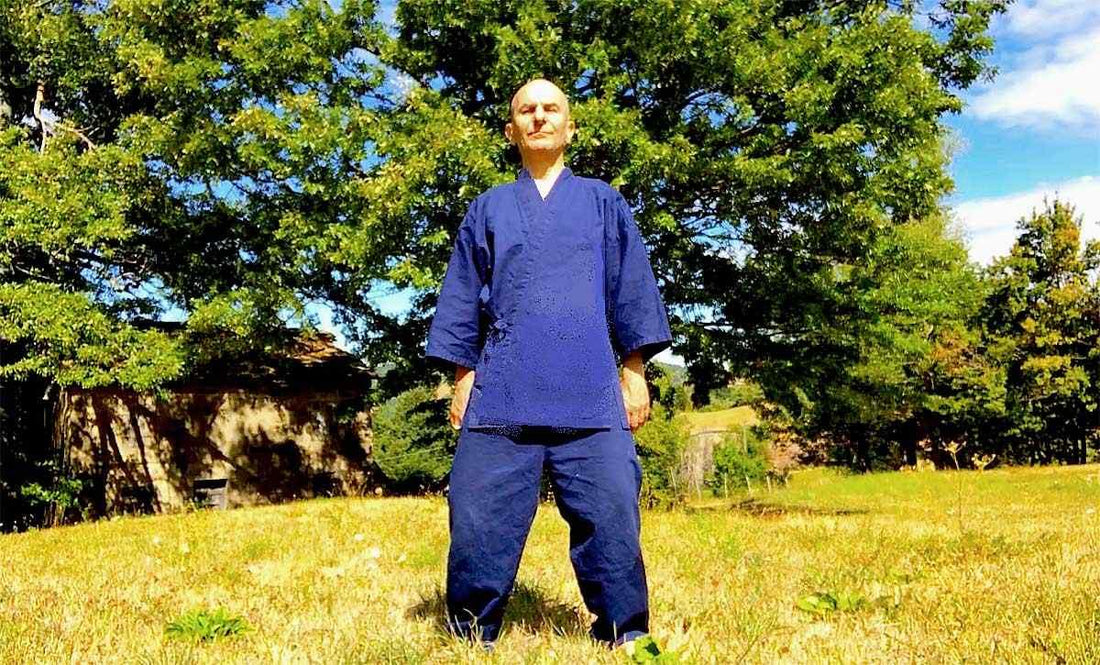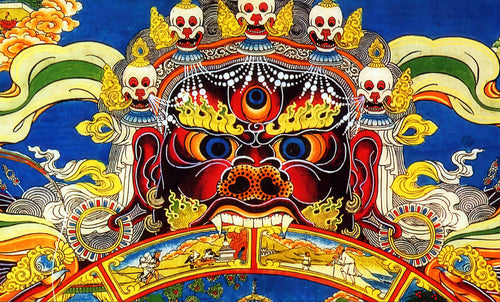
What is Zen Naikan
Leonardo Anfolsi“ When one learns calmness and simplicity, undisturbed by any turbulence, the ancestral energy adapts itself spontaneously, emanating an energy-qi that is pervasive and unbroken[1]. If I hold this energy within me, how can I possibly fall ill? The point is to keep this unbroken energy-qi inside us, pervading and providing support to the whole body[2] so that between the 360 points and the 84,000 pores not even a hairsbreadth lacks it. Know that this is the secret to conserving life.”
Hakuin zenji
Zen Naikan is a gift of the Rinzai school of Zen Buddhism, from the monks and laymen dedicated to developing spiritual, mental, and physical strength.
While thanks to the current materialist mentality we have invented technological prostheses external ourselves, Zen Naikan encourages us to become our own internal source of passion, strength, awareness and freedom.
Historically, Zen Naikan had various sources within the Rinzai stream, and in China even today we have examples of this dynamic Zen teaching; the word naikan was used expressly by Master Hakuin Ekaku only three centuries ago to define a method of cultivating energy associated with a new concept of dynamic meditation practice suited both to laypeople having an active life in society and to practicing monks.
At the age of 18, in 1977, I had the honor of being received at sanzen - discussion of Zen koan in the secret room with the Master - by Master Luigi Mario Engaku Taino at the zenshinji temple, just as two years later I was welcomed in sanzen also by Master Yamada Mumon. It was in that very place that I understood clearly what the power of the dantien can be in an eighty-year-old man, to boot one who had been ill since his youth. Everyone remembers Maestro Mumon for his inexhaustible energy, in spite of his having only one functioning lung, and the astonishing power he could express with his ki-tentai, externalizing his qi[3].
It is certainly thanks to the strength that Master Mumon knew how to manifest, as well as his humanity and open-mindedness, that he became not only head of the Rinzai school in Japan (Rinzai shu), but also president of the Imperial university of Hanazono[4] and - what seems to me most important - the first Zen Master to open the dialog with the West and the Christian world, capable of receiving the first Westerners seeking monastic training. All of this Mumon accomplished while becoming a reference-point for the contemporary Japanese lay world, and earning fame as a calligrapher.
I came to appreciate Hakuin’s genius through my practice and study of zen methods both of the Rinzai (línjì) and Soto (caodong) schools, as well as of vajrayana and dzogchen: Hakuin could read the traditional Mahayana sutras and decipher the subliminal teachings codified in their densely interwoven symbols. The reader may, if desired, consult the third part of the Orategama, where Hakuin hints at a deeper meaning of the Lotus Sutra, and communicates this reading in a letter to a Nichiren nun. It is certain that Hakuin practiced specific meditations to stimulate greatly not only his vitality, but also his intelligence.
Historically, naikan has been shown to possess three qualities:
- to facilitate the comprehension of zen practice by both monks and laypeople
- it heals monks of the zen sickness - zenbyo - that causes the heat to rise and the water element to sink
- stretching the muscles, healing, and making life easier
Note that, from what Hakuin says, naikan was taught also to laymen, which encourages us not to be tempted to keep this information secret, if Hakuin himself had no desire to hide it, but as the Dalai Lama advises[5], to offer those who are ready the opportunity for self-development.
The better WE are, the better a world we create.
Zen Naikan, practiced by Chinese and Japanese zen monks, is a form of yogic ascesis:
- Mental, given that it operates through visualizations and the breath
- Energetic, encouraging the flow of emotional/nervous/pranic energy and the bioelectric/respiratory power of the qi, and
- Physical, using particular movements and breathing techniques to develop the bioelectric and staminal forces. To use the best-known terminology, Zen Naikan integrates the principle of yoga, working with the five pranas, with the essence of qigong, working with the jing[6]
and the qi, to realize the shen.
By ‘staminal’ we mean the germinative, constitutional principle of living organisms of all kingdoms, from the vegetable to the animal all the way to human beings. The word’s Greek and Latin roots evoke the concept of something ancestral, structural, tied to the idea of “standing”, “supporting structure”, “fulcrum”, “thread”. Stem cells may truly be considered a primordial fulcrum, a structure or basic fiber of life. Just as the bioelectrical voltage differential acts as a fulcrum, and the flow of electrical current lies at the base of life and our wellbeing as it moves every function at the cell, tissue, and organ levels.
Let us add that the latest scientific discoveries pertaining to the ‘extrapyramidal nervous system” and the “enteric nervous system”, or “epigenetics” and the development of the concept of “resilience” only provide contemporary scientific confirmation for the principles guiding the ancient methods of Naikan. We may certainly state that the practice of Naikan strengthens our immune or adaptive capacity, and that it is a rapidly-applied technique that allows one to realize those tangible effects commonly termed ‘miracles’ that I have witnessed every day of my life. These experiences are certainly encouraging, but should not so much distract us from our inner seeking as nourish it, opening us to wonder at once innocent and responsible. We must think about this, to understand where we are, what times are these, how we all must - sooner or later - confront the mystery and how it constitutes the very breath of our daily life. In other times, neither better nor worse than today, this perception was an inborn part of humanity, although the human race was more ingenuous and instinctual.
The Naikan we present in this introductory document is not the Naikan of Yoshimoto Ishin - who certainly has our respect - but the alchemical training taught for thousands of years in the Rinzai School of Zen. The tradition is clearly traceable back to the teachings of Hóngren, the fifth Chinese patriarch, continued in Rinzai’s day and - either in accordance with his desire or that of his descendants - represented in the figure of Master Puhuà. We may recognize this continuum through two historical moments in which the Rinzai school gained eminence, first through its influence on the samurai class and finally with Hakuin Ekaku. Maestro Hakuin, true cornerstone of the Rinzai tradition in Japan, authored the two fundamental texts on Naikan that we reproduce within this volume. More recently, we rediscover Naikan in Kōno Dakei and Kawaguchi Ekai. Kawaguchi Ekai taught Yamada Mumon Roshi, who in turn taught Engaku Taino, who is my direct Master. This teaching thus arrives to us through an unbroken line of transmission from Master Hakuin Ekaku, who rediscovered it thanks to his boundless scholarly zeal.
Among the principle studies on the material mentioned above relative to the Rinzai school, we find the studies realized in part by the prestigious scholars of the University of Hanazono - for many years directed by Mumon Roshi himself - and some studies and translations of texts into Western languages[7].
Notes:
[1] The production of the strongest and highest-quality qi - thanks to the integrity of the ancestral energy (jing) - is due in this case to the dynamic calm induced by meditation, under which satori may be realized. Hakuin specifies that the term meditation is to be understood not simply as quiet or mere mental practice (zazen + koan = rikan), but also as an active life, and - thanks to the power that yogic zen meditation has to “distill the elixir” (naikan) - the commitment to put all of one’s innate potentialities on the line.
[2] The idea of holding energy in every acupuncture point and pore of the body is not simply a figure of speech, but the subject of Exercise 19.
[3] The bioelectric energy is called “qi” in Chinese, while the same ideogram in Japanese is read “ki”.
[4] Yamada Mumon detached himself completely from the hyper-nationalistic ideology of one of his Masters, Seise’tsu Ghenshõ, in times in which none yet imagined what was to occur later, but this did not damp the ardor of one detractor who, understanding nothing of the subdued manner in which the Japanese express even their dissent, did not even bother to inform himself of the fact that Master Mumon in Japan was widely considered to be a radical pacifist.
[5] See the chapter on the Eighth Spring.
[6] Jing = genetic nutrient force/qi = bioelectric force/shen = spiritual power. In yoga, prāṇa is the energy that carries nerve impulses to the system, reaching the dense body through imagination (the psycho-soma) and the endocrine secretions; we could define pranic energy as biomagnetic energy. Qi, on the other hand, according to Chinese tradition, is the energy that flows along the surfaces of the body and in the internal tissues, tied to the ‘function’ of the various organs. The qi is therefore already anchored to the dense body, which it fills with bioelectric force as the wind fills the sail. Further on we will specify the nature of these two levels of energy; at the end of the text is included an explanation of these two energetic planes.
[7] Akizuki Ryūmin, Yanagida Seizan, Iriya Yoshitaka, Daisetz Teitaro Suzuki. Paul Demiéville, Gregory and Daniel Getz, T. Griffith Foulk, Peter Gregory, Chi-chiang Huang and Ding-hwa Hsieh, Whalen Lai, Lewis Lancaster, Trevor Legget, Miriam Levering, Ruth Fuller Sasaki, Morten Schlütter, Philip Boas Yampolsky, Burton Watson.
















































